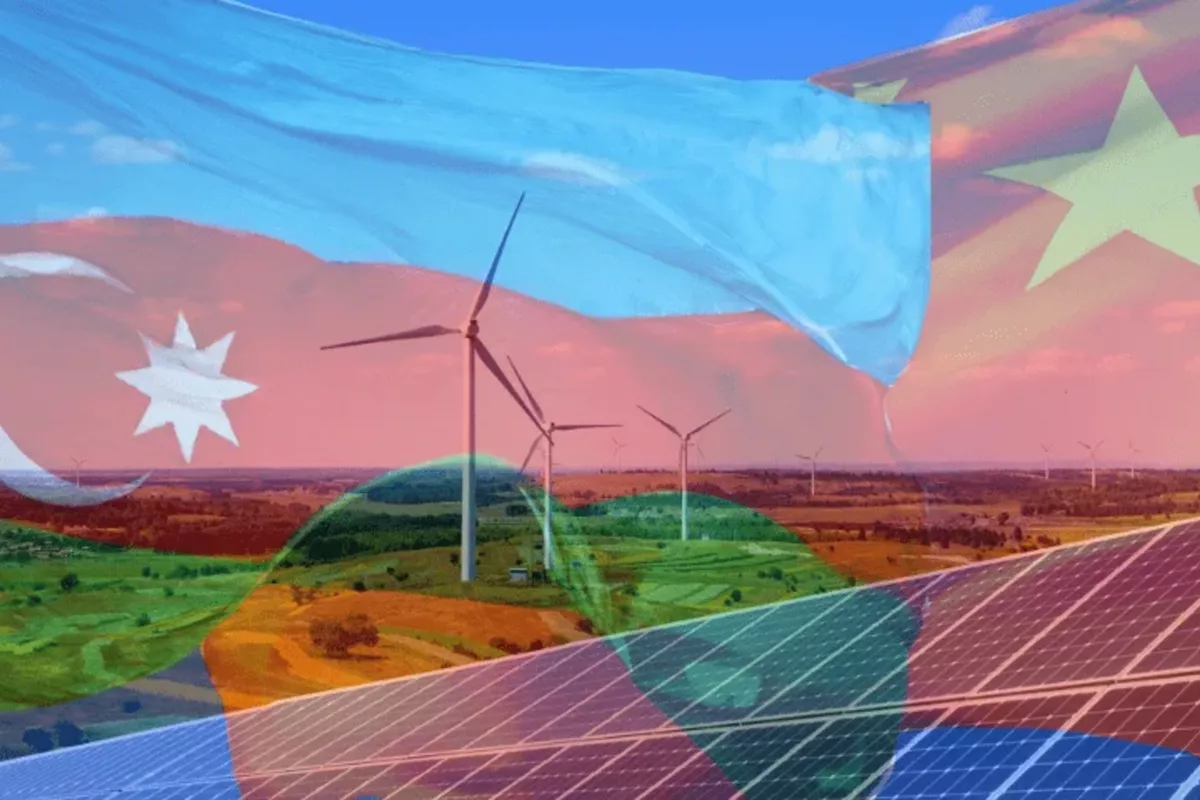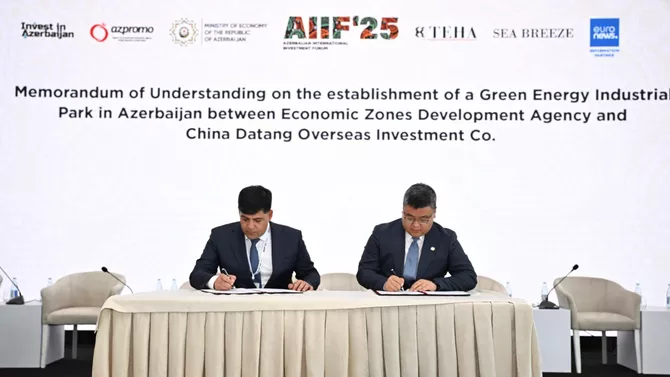
photo: The Diplomatic Insight
Azerbaijan and China are stepping boldly into a new era of cooperation, one that goes beyond traditional trade and infrastructure projects. Their recent focus on renewable energy marks a strategic pivot that could reshape both nations’ energy landscapes while influencing the global green transition. With China’s unrivaled expertise in clean technologies and Azerbaijan’s vast untapped potential for renewable energy development, this partnership is poised to become a cornerstone of sustainable growth across Eurasia.
During the First Azerbaijan International Investment Forum in Baku, the Agency for the Development of Economic Zones under Azerbaijan’s Ministry of Economy and China Datang Overseas Investment Co. signed a landmark Memorandum of Understanding to create a “Green Energy Industrial Park” in Azerbaijan. This is not a symbolic gesture-it is a concrete step toward positioning Azerbaijan as a regional hub for green energy production, technology, and innovation.

photo: Renewables.az
China Datang Corporation Limited is one of China’s top five state-owned power generation companies and operates a wide portfolio of energy and coal assets across 31 provinces in China and beyond, including Myanmar, Laos, Cambodia, Singapore, Indonesia, and Uzbekistan. Partnering with such a global heavyweight reflects Azerbaijan’s seriousness in its green energy ambitions.
This partnership has been building momentum for months. In June, during an official visit to China, Azerbaijan’s Minister of Energy Parviz Shahbazov met with Datang’s Chairman Liu Jun. They signed an agreement focused on developing a “green energy corridor,” a project that will enable secure integration of renewable energy capacity into the national grid and ensure stable and reliable transmission of electricity. This demonstrates a forward-thinking approach, recognizing that renewable power is only as valuable as the infrastructure supporting its delivery.
The breakthrough moment came during President Ilham Aliyev’s state visit to Beijing in April. A series of agreements were signed that elevated renewable energy cooperation to a strategic priority. Both sides expressed readiness to actively develop joint projects in solar and wind energy, promoting the energy transition and sustainable socio-economic development. These deals included investments in solar plants, offshore wind farms, floating solar stations, and battery storage systems. One standout agreement involves a massive 2 GW offshore wind project in the Caspian Sea-a project that has the potential to transform Azerbaijan into a major green power exporter.
The collaboration doesn’t stop there. Chinese companies have shown interest not only in building renewable power facilities in Azerbaijan but also in establishing local production of wind turbines and solar panels. This move will create jobs, develop industrial capacity, and position Azerbaijan as a key link in the energy supply chain stretching from Asia to Europe.
These ambitions are already taking shape. In September, during a high-level Azerbaijani delegation’s visit to Chengdu, a significant investment deal was signed between the Alat Free Economic Zone and Sichuan Sunsync Photovoltaic Technology. The agreement involves building a plant to produce solar panels with an annual capacity of 3 GW. This facility will also manufacture silicon crystals and components, serving both domestic projects and international markets. The panels will be used in the construction of a large-scale solar power plant in Alat, further reinforcing Azerbaijan’s clean energy infrastructure.
President Aliyev has made it clear that Azerbaijan’s renewable energy targets are ambitious. By 2027, the country aims to generate 2 GW from solar and wind power, and by 2030, this figure is expected to triple to 6 GW. “This will be nothing short of a revolution in Azerbaijan’s energy portfolio,” Aliyev said in a January interview with China’s CGTN. He also praised Chinese manufacturers for producing the world’s best solar panels and battery storage systems, emphasizing that no other producers can currently match China in terms of quality and cost-effectiveness.
China’s dominance in the renewable energy sector is indisputable. The country now accounts for over 40% of global patents in renewable energy technology. In recent years, China has set records in solar conversion efficiency, offshore wind turbine capacity, and large-scale energy storage systems. Its extensive electric vehicle charging infrastructure is unmatched globally, with two charging stations for every five EVs. By June 2025, for the first time in history, the combined installed capacity of wind and solar energy in China surpassed that of coal. Analysts at Rystad Energy predict that by 2026, solar will overtake coal as China’s primary energy source-a remarkable milestone for the world’s second-largest economy.

photo: African Energy Week
For Azerbaijan, this collaboration with China is more than just an energy project-it is a geopolitical strategy. By aligning with a global leader in green technology, Azerbaijan strengthens its position as a bridge between Asia and Europe. Chinese corporations will play a vital role in developing energy corridors that can carry clean power across continents, reinforcing Azerbaijan’s role as a critical hub in the global energy network.
As COP29 approaches, the timing of these agreements is symbolic. While many countries are still debating climate commitments, Azerbaijan and China are moving decisively from words to action. Their partnership is a model for how nations can combine resources and expertise to achieve shared goals in sustainability.
In an era where the energy transition is no longer optional but imperative, Azerbaijan’s choice to partner with China appears not just wise but visionary. This alliance demonstrates that the path to a greener future lies in cooperation, innovation, and bold ambition. By embracing China’s advanced technologies and leveraging its own renewable energy potential, Azerbaijan is positioning itself at the forefront of the global clean energy revolution.
Simply put, Azerbaijan has chosen the right partner-and the right moment-to lead in the race toward a sustainable future. This collaboration is not just about building power plants or signing agreements; it is about shaping a new global energy map. By aligning its renewable energy ambitions with China’s technological might and financial power, Azerbaijan is sending a clear message to the world: it intends to be more than just a fossil fuel exporter. It seeks to become a driver of innovation, a regional hub for clean technology, and a bridge linking Asia and Europe through sustainable energy corridors.
As the world accelerates its transition away from hydrocarbons, those countries that embrace green technology early will gain a competitive edge not only in energy production but also in geopolitics and trade. Azerbaijan’s partnership with China positions it to attract massive foreign investment, create thousands of new jobs, and modernize its industrial base. It also allows Baku to diversify its economy, reduce carbon emissions, and meet global climate commitments ahead of schedule.
By joining forces with China, Azerbaijan is not merely participating in the green revolution; it is positioning itself to help lead it. This bold vision reflects a deeper understanding that the future belongs to those who innovate, invest, and collaborate. If these projects succeed, Azerbaijan could emerge as a model for other nations striving to balance economic growth with environmental responsibility-proving that sustainable development is not only possible, but profitable and geopolitically strategic.
Share on social media